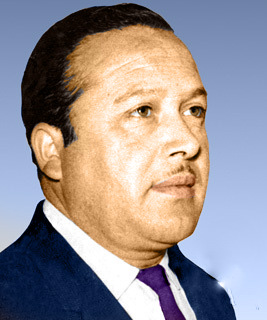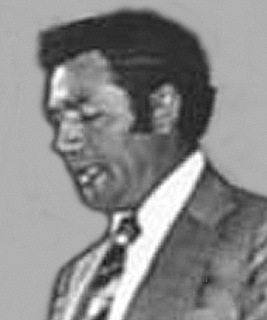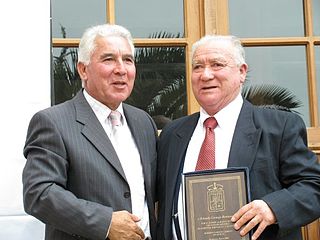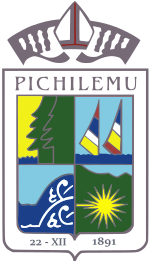
Cardenal Caro Province is one of the three provinces of the central Chilean region of O'Higgins (VI). The capital of Cardenal Caro is Pichilemu.

Colegio de la Preciosa Sangre de Pichilemu, often shortened to Preciosa Sangre, is a coeducational Roman Catholic private state-subsidized day school, serving students in preschool through twelfth grade, located in the commune of Pichilemu, Libertador General Bernardo O'Higgins Region, Chile.

The history of Pichilemu began around the 16th century, when Promaucaes inhabited the modern Pichilemu region. According to Chilean historiographer José Toribio Medina on his book Los Restos Indígenas de Pichilemu (1908), Spanish conqueror Pedro de Valdivia gave Topocalma encomienda, in which Pichilemu was supposed to be, to Juan Gómez de Almagro, on January 24, 1544.
The Mayor of Pichilemu is an elected politician who is the head of the executive branch of government of the commune of Pichilemu, Libertador General Bernardo O'Higgins Region, Chile. The mayor presides over the local city council, composed of six members, and serves as the civic representative of the commune. The mayor is popularly elected in a municipal election, by simple majority. The office is held for a four-year term without term limits.

José María Caro Martínez was a Chilean politician and civil servant. In May 1894, he was unanimously elected as the first mayor of the commune of Pichilemu, with Pedro Nolasco de Mira and Francisco Reyes made second and third magistrate respectively. Caro Martínez had previously served for several years as administrator or llavero of the San Antonio de Petrel hacienda and, between 1891 and 1892, was the Subdelegate of the 13th Subdelegation of San Fernando Department which comprised the district of Cáhuil.
The Governor of Cardenal Caro Province is the appointed head of government of the provincial government in Cardenal Caro Province, Chile. The governor is designated by the President.

René Gabriel Maturana Maldonado was a Chilean journalist and the 36th Mayor of Pichilemu, holding the position from his appointment by President Augusto Pinochet Ugarte on 31 August 1984 until his resignation in April 1992.

Francisco Javier Asalgado was the second and fourth Mayor of the commune of Pichilemu, office which he held between May 1905 and September 1909, and between May and September 1912.
Francisco Adriano Caro Rodríguez was the eighth mayor of the commune of Pichilemu, Chile, an office which he held between December 1925 and May 1927.

Armando Caroca Rojas was the 20th Mayor of the commune of Pichilemu, office which he held between May 1944 and May 1947. He was succeeded by Carlos Echazarreta Larraín. He also was a regidor of Pichilemu for several terms.

Carlos José Ramón Echazarreta Iñiguez was the 27th and 30th Mayor of the commune of Pichilemu, office which he held between May 1963 and May 1967, and through the early months of the Augusto Pinochet military regime, between September and November 1973. In 1967 he was succeeded by Carlos Rojas Pavez, and in 1973 he was succeeded by Mario Urrutia Carrasco. Echazarreta also was a regidor of Pichilemu for several terms between 1959 and 1973.
Carlos Ignacio Rojas Pavez was the 28th Mayor of the commune of Pichilemu, office which he held between May 1967 and May 1971. For almost three decades, Rojas Pavez worked as the municipal secretary of Pichilemu, and in 1944, along with José Arraño Acevedo and Miguel Larravide Blanco, founded Pichilemu, a newspaper focused in local stories.

Washington Saldías Fuentealba was the 29th Mayor of the commune of Pichilemu, office which he held between May 1971 and September 1973: his term was interrupted by the 1973 Chilean coup d'état, which put General Augusto Pinochet in the power of the country, and who later appointed Carlos Echazarreta Iñiguez as the successor of Saldías. Saldías was also regidor of the commune of Pichilemu between 1963 and 1971, and a founding member of the Club Aéreo de Pichilemu.

Víctor Eduardo Parraguez Galarce was the 32nd Mayor of the commune of Pichilemu, office which he held between 1975 and 1979, after being appointed by the government junta presided by General Augusto Pinochet. Parraguez Galarce is also an agricultural entrepreneur, and had an important role in the committee that prompted the creation of the province of Cardenal Caro, in his home region.

José Lino Vargas Jorquera is a Chilean politician. He was the 33rd Mayor of the commune of Pichilemu, office which he held between 1979 and 1981, after being appointed by the government junta presided by General Augusto Pinochet. The Cardenal Caro Province, of which Pichilemu is the capital, was created during Vargas' term as mayor. He also was a founding member of the Club Aéreo de Pichilemu ; Vargas is an experienced pilot.
Gustavo Osvaldo Parraguez Galarce is the municipal secretary of Pichilemu, and was the interim Mayor of the commune of Pichilemu three different times, in 1992, 2007, and 2008.

Orlando Cornejo Bustamante was the 37th Mayor of the commune of Pichilemu, office which he held between September 1992 and December 1996, representing the Union of the Centrist Center (UCC). He was the first mayor of Pichilemu to be elected following the Chilean transition to democracy. In 1996 and 2000, he ran again as a candidate in the municipal elections of these years, but failed to be elected in either.

Pedro Pablo Caro Rodríguez was a Chilean lawyer. After obtaining the degree of law and political sciences from the University of Chile, he worked as an independent lawyer in Rancagua, and served as acting judges in several communes and departments in Chile, including San Carlos, Curicó, Nacimiento, among others. He was also a secretary and treasurer of the municipality of Buin. Caro Rodríguez was member of the Conservative Party of Chile, and later of the Christian Democrat Party of Chile.
Cardenal Caro Department was one of the departments of Chile located in Colchagua Province.

Pichilemu, originally known as Pichilemo, is a beach resort city and commune in central Chile, and capital of Cardenal Caro Province in the O'Higgins Region. The commune comprises an urban centre and twenty-two villages, including Ciruelos, Cáhuil, and Espinillo. It is located southwest of Santiago. Pichilemu had over 13,000 residents as of 2012.



















